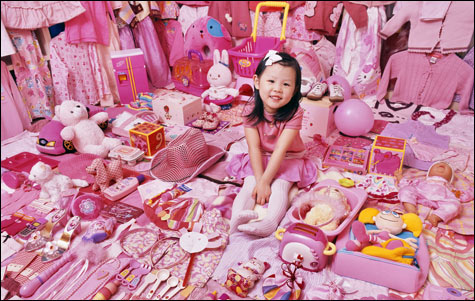
SEOHYUN AND HER PINK THINGS JeongMee Yoon, like the other artists in “Cornucopia,” has a love-hate relationship with all our shiny junk.
|
One of the essential lessons I’ve gleaned from the magazine Martha Stewart Living is that if you put together a collection of junk that’s all the same color (or maybe two colors), it’s almost always interesting to look at.
Sure, Martha is the MacGyver of home decorating — she can turn a stick of gum, some pocket lint, and a paper clip into a smashing holiday centerpiece. And her publications always reminds me of the allure of photographing with a shallow depth of field, so that only the thing you’re looking at is in focus and everything else goes seductively blurry. But in the end, her decorating style comes down to colors — the fewer the prettier.
I was reminded of this the other day when I visited the sharp exhibit “Cornucopia: Documenting the Land of Plenty” at Montserrat College of Art. The centerpiece is New Yorker Portia Munson’s Green Piece: Lawn (2007), a heap of (mostly) plastic junk that fills a rectangle in the middle of the gallery floor. The stuff is attractively old and broken and tired — artificial trees and plants, a toy tractor, lawn furniture, a sled, a boot, water bottles, trash barrels, motor oil, a can of bug spray, hair-conditioner jugs, toy frogs, and alligators and dinosaurs. What makes it magnetic is that everything is green — all different shades of green.
“Cornucopia,” a five-artist show organized by Montserrat curator Leonie Bradbury, is a portrait of America as a super-acquisitive consumer society. The artists themselves seem to have a love/hate relationship with all our shiny junk. An air of doom hovers over the proceedings — the focus is frequently the beauty of ruins. September 11 is evoked by way of President Bush’s efforts to maintain confidence in the US economy after the attack on the World Trade Center (and thus a symbolic attack on America’s world trade): “I encourage you all to go shopping more.” Also addressed are our global-warming-era fears of the toxic consequences of our mass-produced, synthetic, artificially flavored, technologically manipulated society.
And so Munson’s Green Piece (Greenpeace, get it?) mulls “green” as a code word for all that is eco-friendly — and increasingly “green” as in profitable, as well. It touches on all the contradictions and questions and feelings of duty and guilt that the label “green” now raises. A lawn, she notes, is just one more human mutation of nature. Her acid punch line: at the center of the junk sits a green plastic Waste Management recycling bin.
South Korean artist JeongMee Yoon’s four photographs from her “Pink and Blue Project” depict little kids with all their pink (for girls) or blue (for boys) stuff neatly laid out around them. There’s blue action figures, superheroes, weapons, and balls for boys, pink baby dolls, bows, stuffed animals, and toy dishes for girls. Again the photos are attractive because of the limited colors. It’s as if the kids’ whole world were pink or blue — the kids are even dressed in pink or blue. The images attest to the force and pervasiveness of gender indoctrination in our society. But the photo that sticks with me is Seohyun and Her Pink Things (2007), because Seohyun flashes this big smile. She seems incredibly happy.
Yoon combines two tactics popular in photography today: photographing people and things as specimens, and photographing dazzling inundations. Danwen Xing of China and Chris Jordan of Seattle adopt similar styles for their photos of piles of junk — old cellphones, diodes, cords, adapters, circuit boards — that become pretty, abstract patterns.
Chicago’s Brian Ulrich offers boring shots, in the popular deadpan photo style, of a woman talking on her cellphone in front of a supermarket refrigerator case, a boy staring at model fantasy warriors in a shop, and piles of used shoes and computer gear in thrift shops.
Over at Boston University’s Photographic Resource Center, the nine-artist exhibit “Ad/Agency,” organized by the center’s Leslie K. Brown, touches on similar consumerist America themes but examines them through the lens of advertising.
The best stuff here is New Yorker Penelope Umbrico’s Mirrors (from Catalogs), from 2002. She rephotographs pictures of mirrors — with their reflections — in home-improvement catalogues and then prints them at the real-life size of the mirror featured. Out of the corner of your eye they feel like real mirrors, but when you look at them, they show the carefully styled rooms in the catalogues: a tree on a bureau, a blurry soft white bed, perfume bottles neatly arranged on a dresser. They are literal reflections of our desires, epitomizing the ordered ideal of the American dream life. But they are places we can never enter.